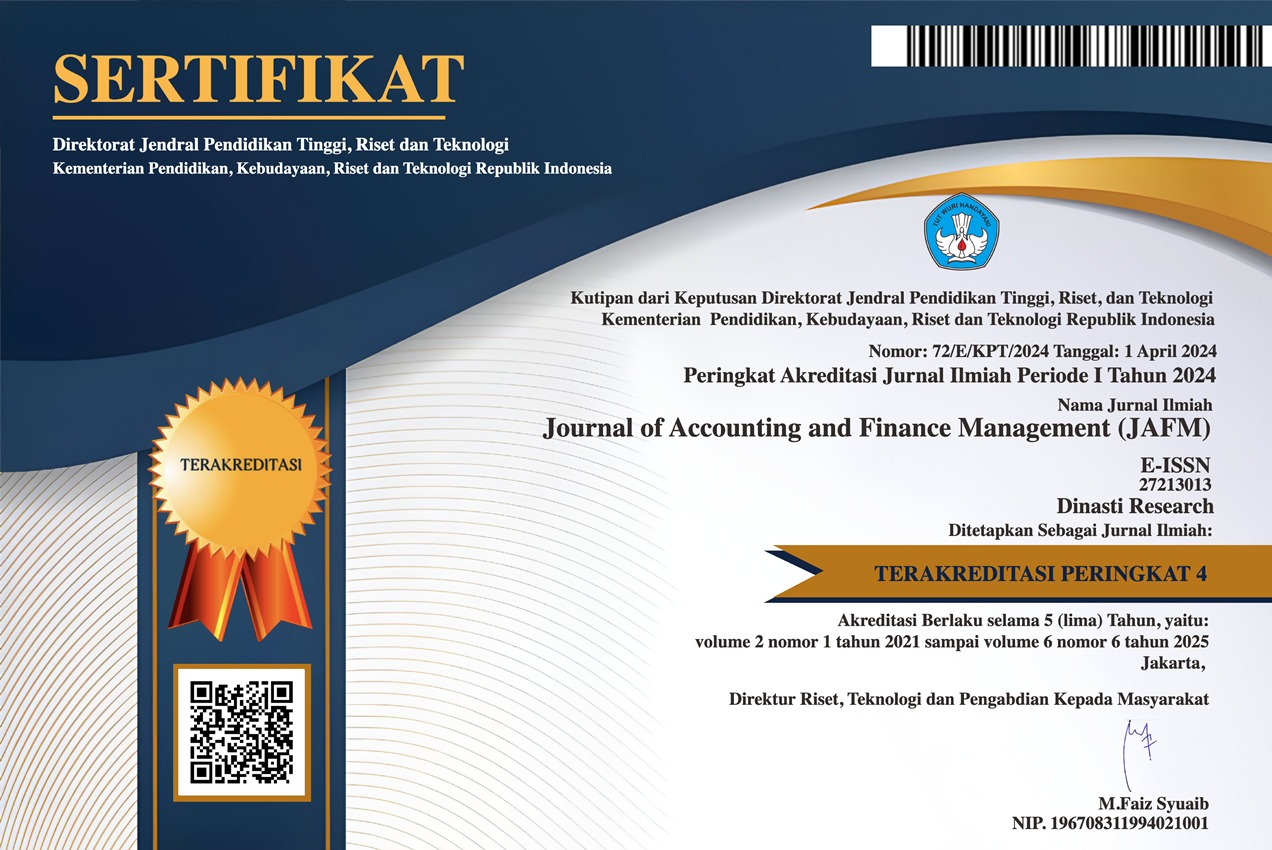Strategic Innovation and Emerging Markets: Bibliometric Analysis of Trends, Issues and Future Directions
DOI:
https://doi.org/10.38035/jafm.v5i3.695Keywords:
Strategic Innovation, Emerging Market, Bibliometric AnalysisAbstract
This study uses bibliometric analysis to investigate the complex connections between strategic innovation and emerging market. In this dynamic subject, it highlights prospective future research directions and indicates important obstacles and emerging trends. A carefully selected group of 5,467 research papers is extracted from the vast Scopus database using a custom search phrase that is intended to highlight strategic innovation and emerging markets. After a rigorous manual screening procedure that follows the PRISMA protocol, 496 studies are carefully chosen for in-depth bibliometric analysis. This study uses scientific mapping tools to visually display the complex interactions and interconnections among diverse research streams in addition to analyzing the performance of these This study uses bibliometric analysis to investigate the complex connections between strategic innovation and emerging market. In this dynamic subject, it highlights prospective future research directions and indicates important obstacles and emerging trends. A carefully selected group of 5,467 research papers is extracted from the vast Scopus database using a custom search phrase that is intended to highlight strategic innovation and emerging markets. After a rigorous manual screening procedure that follows the PRISMA protocol, 496 studies are carefully chosen for in-depth bibliometric analysis. This study uses scientific mapping tools to visually display the complex interactions and interconnections among diverse research streams in addition to analyzing the performance of these selected publications. The results highlight how important it is for firms to be ambidextrous in order to effectively handle the variety of difficulties and new opportunities that growing markets bring. The capacity to simultaneously investigate novel ideas and make use of current resources becomes essential in this dynamic environment in order to ensure long-term success. This study effectively synthesizes previous material by offering a unique viewpoint on the complex links between strategic innovation and emerging markets. It provides insightful information that advances our knowledge of how companies can successfully negotiate the challenging terrain of emerging markets and adopt strategic innovation in order to prosper in this revolutionary climate.
References
Abbas, M., Shahid Nawaz, M., Ahmad, J., & Ashraf, M. (2017). The effect of innovation and consumer related factors on consumer resistance to innovation. Cogent Business and Management, 4(1). https://doi.org/10.1080/23311975.2017.1312058
Adel, H. M. (2021). Mapping and Assessing Green Entrepreneurial Performance: Evidence from a Vertically Integrated Organic Beverages Supply Chain. Journal of Entrepreneurship and Innovation in Emerging Economies, 7(1), 78–98. https://doi.org/10.1177/2393957520983722
Ajayi, R. A., Mehdian, S., & Stoica, O. (2018). An Empirical Examination of the Dissemination of Equity Price Innovations Between the Emerging Markets of Nordic-Baltic States and Major Advanced Markets. Emerging Markets Finance and Trade, 54(3), 642–660. https://doi.org/10.1080/1540496X.2017.1419426
Akbari, M., Nobari, N., Mokhtari, H., Padash, H., & Moradi, A. (2022). Exploring the Co-Effect of Market-Orientation and Ambidextrous Innovation in Service Innovation of SMEs. Iranian Journal of Management Studies, 15(4), 663–682. https://doi.org/10.22059/IJMS.2021.328741.674711
Al-Jamimi, H. A., BinMakhashen, G. M., & Bornmann, L. (2022). Use of bibliometrics for research evaluation in emerging markets economies: a review and discussion of bibliometric indicators. Scientometrics, 127(10), 5879–5930. https://doi.org/10.1007/s11192-022-04490-8
Al-Kwifi, O. S., Farha, A. K. A., & Zaraket, W. S. (2020). Competitive Dynamics Between Multinational Companies and Local Rivals in Emerging Markets. FIIB Business Review, 9(3), 189–204. https://doi.org/10.1177/2319714520939673
Alexandrovskiy, S., Shushkin, M., & Fomenkov, D. (2022). Types of imitation and startup market performance: the case of Russia. International Journal of Business Innovation and Research, 28(1), 22–42. https://doi.org/10.1504/IJBIR.2022.122966
Barney, J. (1991). Firm Resources and Sustained Competitive Advantage. Journal of Management. https://doi.org/10.1177/014920639101700108
Bartnik, R., & Park, Y. (2018). Technological change, information processing and supply chain integration. Benchmarking: An International Journal, 25(5), 1279–1301. https://doi.org/10.1108/BIJ-03-2016-0039
Battistella, C., Ferraro, G., & Pessot, E. (2023). Technology transfer services impacts on open innovation capabilities of SMEs. Technological Forecasting and Social Change, 196, 122875. https://doi.org/https://doi.org/10.1016/j.techfore.2023.122875
Bellis, P., Buganza, T., & Verganti, R. (2023). What kind of intimacy is meaningful to you? How intimate interactions foster individuals’ sensemaking of innovation. Creativity and Innovation Management, 32(3), 407–424. https://doi.org/https://doi.org/10.1111/caim.12568
Bu, X., & Chen, L. (2023). From efficiency to legitimacy: the changing logic of internal CSR in emerging multinationals during internationalization. Asian Business and Management, 22(4), 1418–1453. https://doi.org/10.1057/s41291-022-00213-2
Buccieri, D. (2020). International entrepreneurial culture, innovation differentiation strategy and early internationalisation: Evidence from Indian born globals. International Journal of Services, Economics and Management, 11(3), 274–301. https://doi.org/10.1504/IJSEM.2020.111198
Buccieri, Dominic, Javalgi, R. G., & Gross, A. (2021). Innovation and differentiation of emerging market international new ventures the role of entrepreneurial marketing. Journal of Strategic Marketing, 00(00), 1–29. https://doi.org/10.1080/0965254X.2021.1952293
Campra, M., Riva, P., Oricchio, G., & Brescia, V. (2021). Bibliometrix analysis of medical tourism. Health Services Management Research. https://doi.org/10.1177/09514848211011738
Caputo, A., Pizzi, S., Pellegrini, M. M., & Dabi?, M. (2021). Digitalization and business models: Where are we going? A science map of the field. Journal of Business Research, 123(February 2020), 489–501. https://doi.org/10.1016/j.jbusres.2020.09.053
Cataltepe, V., Kamasak, R., Bulutlar, F., & Palalar Alkan, D. (2023). Dynamic and marketing capabilities as determinants of firm performance: evidence from automotive industry. Journal of Asia Business Studies, 17(3), 617–638. https://doi.org/10.1108/JABS-11-2021-0475
Chabowski, B. R., & Samiee, S. (2022). A bibliometric examination of the literature on emerging market MNEs as the basis for future research. Journal of Business Research, 155, 113263. https://doi.org/https://doi.org/10.1016/j.jbusres.2022.08.027
Chakravarty, S. (2022). Resource constrained innovation in a technology intensive sector: Frugal medical devices from manufacturing firms in South Africa. Technovation, 112, 102397. https://doi.org/https://doi.org/10.1016/j.technovation.2021.102397
Dahan, N. M., Doh, J. P., Oetzel, J., & Yaziji, M. (2010). Corporate-NGO collaboration: Co-creating new business models for developing markets. Long Range Planning, 43(2–3), 326–342. https://doi.org/10.1016/j.lrp.2009.11.003
Dai, X., Siddik, A. B., & Tian, H. (2022). Corporate Social Responsibility, Green Finance and Environmental Performance: Does Green Innovation Matter? Sustainability (Switzerland), 14(20). https://doi.org/10.3390/su142013607
Dawar, N., & Frost, T. (1999). Competing with giants. Survival strategies for local companies in emerging markets. Harvard Business Review, 77(2), 119-129,187.
de Ruyter, K., Keeling, D. I., Plangger, K., Montecchi, M., Scott, M. L., & Dahl, D. W. (2022). Reimagining marketing strategy: driving the debate on grand challenges. Journal of the Academy of Marketing Science, 50(1), 13–21. https://doi.org/10.1007/s11747-021-00806-x
Demirkan, I., Yang, Q., & Jiang, C. X. (2019). Corporate entrepreneurship of emerging market firms: current research and future directions. New England Journal of Entrepreneurship, 22(1), 5–30. https://doi.org/10.1108/NEJE-04-2019-0024
Dervis, H. (2019). Bibliometric analysis using bibliometrix an R package. Journal of Scientometric Research, 8(3), 156–160. https://doi.org/10.5530/JSCIRES.8.3.32
Ding, L., Ye, R. M., & Wu, J. (2019). Platform strategies for innovation ecosystem: Double-case study of Chinese automobile manufactures. Journal of Cleaner Production, 209, 1564–1577. https://doi.org/https://doi.org/10.1016/j.jclepro.2018.11.139
Ding, W., & Ding, J. (2022). New venture’s product innovativeness strategy, institutional environment and new product performance. Technological Forecasting and Social Change, 174, 121211. https://doi.org/https://doi.org/10.1016/j.techfore.2021.121211
Dissanayake, H., Iddagoda, A., & Popescu, C. (2022). Entrepreneurial Education at Universities: A Bibliometric Analysis. Administrative Sciences, 12(4). https://doi.org/10.3390/admsci12040185
Do, B., Nguyen, N., D’Souza, C., Bui, H. D., & Nguyen, T. N. H. (2022). Strategic responses to COVID-19: The case of tour operators in Vietnam. Tourism and Hospitality Research, 22(1), 5–17. https://doi.org/10.1177/1467358421993902
Donthu, N., Kumar, S., Mukherjee, D., Pandey, N., & Lim, W. M. (2021). How to conduct a bibliometric analysis: An overview and guidelines. Journal of Business Research, 133(April), 285–296. https://doi.org/10.1016/j.jbusres.2021.04.070
Dubiel, A., & Mukherji, P. (2022). Same, same but different! New service development in the context of emerging markets: a review. International Marketing Review, 39(5), 1226–1251. https://doi.org/10.1108/IMR-01-2021-0047
Eferin, Y., Hohlov, Y., & Rossotto, C. (2019). Digital platforms in Russia: competition between national and foreign multi-sided platforms stimulates growth and innovation. Digital Policy, Regulation and Governance , 21(2), 129–145. https://doi.org/10.1108/DPRG-11-2018-0065
Eisenhardt, K. M., & Brown, S. L. (1999). Patching. Restitching business portfolios in dynamic markets. Harvard Business Review, 77(3), 72-82,208.
Elango, B. (2019). A Bibliometric Analysis of Franchising Research (1988–2017). The Journal of Entrepreneurship, 28(2), 223–249. https://doi.org/10.1177/0971355719851897
Enderwick, P., & Buckley, P. J. (2021). The role of springboarding in economic catch-up: A theoretical perspective. Journal of International Management, 27(3). https://doi.org/10.1016/j.intman.2021.100832
Farida, I., & Setiawan, D. (2022). Business Strategies and Competitive Advantage: The Role of Performance and Innovation. Journal of Open Innovation: Technology, Market, and Complexity, 8(3), 1–16. https://doi.org/10.3390/joitmc8030163
Ferreira, F. A. F. (2018). Mapping the field of arts-based management: Bibliographic coupling and co-citation analyses. Journal of Business Research, 85(September 2015), 348–357. https://doi.org/10.1016/j.jbusres.2017.03.026
Ferreira, J. J., & Teixeira, A. A. C. (2019). Open innovation and knowledge for fostering business ecosystems. Journal of Innovation and Knowledge, 4(4), 253–255. https://doi.org/10.1016/j.jik.2018.10.002
Ferreira, M. P., dos Reis, N. R., & Pinto, C. F. (2016). Three decades of strategic management research on M&As: Citations, co-citations, and topics. Global Economics and Management Review, 21(1–2), 13–24. https://doi.org/10.1016/j.gemrev.2015.12.002
Fithri, P., Games, D., Lina, E. C., & Hidayat, R. (2020). Factors influencing SME innovation in local government: The case of SMEs in Nagari. International Journal of Management, 11(4), 221–231. https://doi.org/10.34218/IJM.11.4.2020.023
Fregidou-Malama, M, Chowdhury, E. H., & Hyder, A. S. (2023). International marketing strategy of emerging market firms: the case of Bangladesh. Journal of Asia Business Studies, 17(4), 804–823. https://doi.org/10.1108/JABS-12-2021-0504
Fregidou-Malama, Maria, Chowdhury, E. H., & Hyder, A. S. (2023). International marketing strategy of emerging market firms: the case of Bangladesh. Journal of Asia Business Studies, 17(4), 804–823. https://doi.org/10.1108/JABS-12-2021-0504
Frynas, J. G., Mol, M. J., & Mellahi, K. (2018). Management innovation made in China: Haier’s Rendanheyi. California Management Review, 61(1), 71–93. https://doi.org/10.1177/0008125618790244
García-Lillo, F., Claver, E., Marco-Lajara, B., Seva-Larrosa, P., & Ruiz-Fernández, L. (2021). MNEs from emerging markets: a review of the current literature through “bibliographic coupling” and social network analysis. International Journal of Emerging Markets, 16(8), 1912–1942. https://doi.org/10.1108/IJOEM-03-2019-0170
Gatignon, H., & Xuereb, J.-M. (1997). Strategic Orientation of the Firm and New Product Development. Journal of Marketing Research, 34(1), 77–90.
Giachetti, C. (2016). Competing in Emerging Markets: Performance Implications of Competitive Aggressiveness. Management International Review, 56(3), 325–352. https://doi.org/10.1007/s11575-015-0263-6
Glen, J., Lee, K., & Singh, A. (2001). Persistence of profitability and competition in emerging markets. Economics Letters, 72(2), 247–253. https://doi.org/https://doi.org/10.1016/S0165-1765(01)00425-6
Gorodnichenko, Y., Svejnar, J., & Terrell, K. (2010). Globalization and innovation in emerging markets. American Economic Journal: Macroeconomics, 2(2), 194–226. https://doi.org/10.1257/mac.2.2.194
Govindarajan, V., & Ramamurti, R. (2011). Reverse innovation, emerging markets, and global strategy. Global Strategy Journal, 1(3–4), 191–205. https://doi.org/https://doi.org/10.1002/gsj.23
Guo, H., Guo, A., & Ma, H. (2022). Inside the black box: How business model innovation contributes to digital start-up performance Hai. Journal of Innovation & Knowledge, 7(4), 100264. https://doi.org/10.1016/j.jik.2022.100264
Guseva, O. A., & Stepanova, A. N. (2021). Startups in Russia: Ownership and performance. Zhournal Novoi Ekonomicheskoi Associacii /Journal of the New Economic Association, 52(4), 67–97. https://doi.org/10.31737/2221-2264-2021-52-4-3
He, J., & Ge, J. (2023). The dual impetus for perceived brand globalness and brand competence in a rapidly changing environment: the role of Brand-Nation Connection. International Marketing Review, 40(1), 4–27. https://doi.org/10.1108/IMR-06-2021-0210
Hellström, T., & Hellström, C. (2017). Achieving impact: impact evaluations and narrative simplification. Prometheus, 35(3), 215–230. https://doi.org/10.1080/08109028.2018.1522829
Hsu, C.-C., Tan, K.-C., Hanim, S., & Zailani, M. (2016). Strategic orientations, sustainable supply chain initiatives, and reverse logistics: Empirical evidence from an emerging market. International Journal of Operations & Production Management, 36(1), 360. https://www.emeraldinsight.com/doi/pdfplus/10.1108/IJOPM-06-2014-0252
Iris Quan, X., & Qi, S. (2020). PhiChem: An Entrepreneurship Case Study of a Hidden Champion in China. IEEE Engineering Management Review, 48(4), 92–101. https://doi.org/10.1109/EMR.2020.2993240
Islam, N., Gyoshev, S., & Amona, D. (2020). External complexities in discontinuous innovation-based R&D projects: Analysis of inter-firm collaborative partnerships that lead to abundance. Technological Forecasting and Social Change, 155, 119303. https://doi.org/https://doi.org/10.1016/j.techfore.2018.05.014
Iwami, S., Ojala, A., Watanabe, C., & Neittaanmäki, P. (2020). A bibliometric approach to finding fields that co-evolved with information technology. Scientometrics, 122(1), 3–21. https://doi.org/10.1007/s11192-019-03284-9
Iyer, G. R., LaPlaca, P. J., & Sharma, A. (2006). Innovation and new product introductions in emerging markets: Strategic recommendations for the Indian market. Industrial Marketing Management, 35(3), 373–382. https://doi.org/10.1016/j.indmarman.2005.02.007
Jia, X., Li, B., Liu, Z. F., & Sun, C. (2023). The green effects of fund market – analysis based on institutional investors’ preference. Kybernetes, 52(2), 495–517. https://doi.org/10.1108/K-11-2021-1120
Jiang, Y., Ma, Z., & Wang, X. (2023). The impact of knowledge management on intellectual property risk prevention: analysis from China’s strategic emerging industries. Journal of Knowledge Management, 27(1), 197–207. https://doi.org/10.1108/JKM-03-2022-0216
Jin, J., & McKelvey, M. (2019). Building a sectoral innovation system for new energy vehicles in Hangzhou, China: Insights from evolutionary economics and strategic niche management. Journal of Cleaner Production, 224, 1–9. https://doi.org/10.1016/j.jclepro.2019.03.118
Johnson, W. H. A., Bicen, P., & Zhu, Z. (2023). Being lean: Conceptualizing and operationalizing the Lean Innovation Capability (LIC) of innovative companies. Technovation, 126, 102794. https://doi.org/https://doi.org/10.1016/j.technovation.2023.102794
Junni, P., Chang, Y.-Y., & Sarala, R. M. (2020). Ambidextrous orientation and performance in corporate venture units: A multilevel analysis of CV units in emerging market multinationals. Long Range Planning, 53(6). https://doi.org/10.1016/j.lrp.2019.101930
Kafouros, M. I., & Forsans, N. (2012). The role of open innovation in emerging economies: Do companies profit from the scientific knowledge of others? Journal of World Business, 47(3), 362–370. https://doi.org/10.1016/j.jwb.2011.05.004
Kalasin, K., Dussauge, P., & Rivera-Santos, M. (2014). The Expansion of Emerging Economy Firms into Advanced Markets: The Influence of Intentional Path-Breaking Change. Global Strategy Journal, 4(2), 75–103. https://doi.org/10.1111/j.2042-5805.2014.1076.x
Kalyar, M. N., Shafique, I., & Ahmad, B. (2020). Effect of innovativeness on supply chain integration and performance: Investigating the moderating role of environmental uncertainty. International Journal of Emerging Markets, 15(2), 362–386. https://doi.org/10.1108/IJOEM-09-2018-0486
Kesavapanikkar, P., Amit, R. K., & Ramu, P. (2023). Product as a service (PaaS) for traditional product companies: an automotive lease practice evaluation. Journal of Indian Business Research, 15(1), 40–54. https://doi.org/10.1108/JIBR-04-2022-0107
Khan, H., Freeman, S., & Lee, R. (2021). New product performance implications of ambidexterity in strategic marketing foci: a case of emerging market firms. Journal of Business and Industrial Marketing, 36(3), 390–399. https://doi.org/10.1108/JBIM-01-2020-0003
Lee, J. Y., Jiménez, A., Yang, Y. S., & Irisboev, I. (2022). The evolution of emerging market firms and time until subsidiary exit: Competitive dynamics of domestic market followers and contingency factors. Journal of Business Research, 145, 694–704. https://doi.org/https://doi.org/10.1016/j.jbusres.2022.03.029
Leonardus, W., Wasono, M., & Alamsjah, F. (2018). Digital transformation in the age of industry 4.0: Acceleration of transformational performance through business model innovation and co-creation strategy in indonesian ict firms. Opcion, 34(86), 2145–2159. https://www.scopus.com/inward/record.uri?eid=2-s2.0-85064140418&partnerID=40&md5=fc70db95a93ea582616b7e617b5ec301
Li, J., Chen, D., & Shapiro, D. M. (2010). Product innovations in emerging economies: The role of foreign knowledge access channels and internal efforts in Chinese firms. Management and Organization Review, 6(2), 243–266. https://doi.org/10.1111/j.1740-8784.2009.00155.x
Liu, W., Wang, J., Jia, F., & Choi, T.-M. (2022). Blockchain announcements and stock value: a technology management perspective. International Journal of Operations & Production Management, 42(5), 713–742. https://doi.org/10.1108/IJOPM-08-2021-0534
Lopez-Vega, H., & Tell, F. (2021). Technology strategy and MNE subsidiary upgrading in emerging markets. Technological Forecasting and Social Change, 167. https://doi.org/10.1016/j.techfore.2021.120709
Luo, X., Cao, D., Tjahjono, B., & Adegbile, A. (2022). Business model innovation themes of emerging market enterprises: Evidence in China. Journal of Business Research, 139, 1619–1630. https://doi.org/https://doi.org/10.1016/j.jbusres.2021.10.080
Luo, Y., & Tung, R. L. (2007). International expansion of emerging market enterprises: A springboard perspective. Journal of International Business Studies, 38(4), 481–498. https://doi.org/10.1057/palgrave.jibs.8400275
Lynch, R., & Jin, Z. (2016). Knowledge and innovation in emerging market multinationals: The expansion paradox. Journal of Business Research, 69(5), 1593–1597. https://doi.org/10.1016/j.jbusres.2015.10.023
Ma, J., & Xu, Y. (2022). The reverse innovation strategies of the latecomer firms - a multiple-case study from China. International Journal of Technology Management, 91(1–2), 107–132. https://doi.org/10.1504/IJTM.2023.127859
Mahdaly, K., & Adeinat, I. (2022). Factors that affect the adoption of RFID in the Saudi logistics industry: an empirical investigation. The International Journal of Logistics Management, 33(3), 1017–1039. https://doi.org/10.1108/IJLM-11-2020-0456
Maradana, R. P., Pradhan, R. P., Dash, S., Gaurav, K., Jayakumar, M., & Chatterjee, D. (2017). Does innovation promote economic growth? Evidence from European countries. Journal of Innovation and Entrepreneurship, 6(1), 1–23. https://doi.org/10.1186/s13731-016-0061-9
Ni, Y., Cheng, Y.-R., & Huang, P. (2020). Do intellectual capitals matter to firm value enhancement? Evidences from Taiwan. Journal of Intellectual Capital. https://doi.org/10.1108/JIC-10-2019-0235
Noble, P. M., & Gruca, T. S. (1999). Industrial Pricing: Theory and Managerial Practice. Marketing Science, 18(3), 455–457. https://doi.org/10.1287/mksc.18.3.455
Nuseir, M. T. (2018). Digital media impact on smes performance in the UAE. Academy of Entrepreneurship Journal, 24(2). https://www.scopus.com/inward/record.uri?eid=2-s2.0-85049977005&partnerID=40&md5=b8a2195b1229291efe0a885ae04eeb8f
Nwachukwu, C., & Vu, H. M. (2020). Strategic flexibility, strategic leadership and business sustainability nexus. International Journal of Business Environment, 11(2), 125–143. https://doi.org/10.1504/IJBE.2020.107500
Ochie, C., Nyuur, R. B., Ludwig, G., & Cunningham, J. A. (2022). Dynamic capabilities and organizational ambidexterity: New strategies from emerging market multinational enterprises in Nigeria. Thunderbird International Business Review, 64(5), 493–509. https://doi.org/10.1002/tie.22266
Padilla-Lozano, C. P., & Collazzo, P. (2022). Corporate social responsibility, green innovation and competitiveness – causality in manufacturing. Competitiveness Review, 32(7), 21–39. https://doi.org/10.1108/CR-12-2020-0160
Page, M. J., McKenzie, J. E., Bossuyt, P. M., Boutron, I., Hoffmann, T. C., Mulrow, C. D., Shamseer, L., Tetzlaff, J. M., Akl, E. A., Brennan, S. E., Chou, R., Glanville, J., Grimshaw, J. M., Hróbjartsson, A., Lalu, M. M., Li, T., Loder, E. W., Mayo-Wilson, E., McDonald, S., … Moher, D. (2021). The PRISMA 2020 statement: An updated guideline for reporting systematic reviews. The BMJ, 372, 2020–2021. https://doi.org/10.1136/bmj.n71
Pandey, S., Pandey, N., & Chawla, D. (2023). Market segmentation based on customer experience dimensions extracted from online reviews using data mining. Journal of Consumer Marketing, ahead-of-p(ahead-of-print). https://doi.org/10.1108/JCM-10-2022-5654
Papapanagiotou, K., Rotsios, K., & Sklavounos, N. (2021). Innovating in Emerging Markets by Building Meaningful it Alliances. Studies in Business and Economics, 16(3), 160–172. https://doi.org/10.2478/sbe-2021-0052
Park, K. M. (2021). Navigating the digital revolution and crisis times: humanitarian and innovation-inspired leadership through the pandemic. Journal of Strategy and Management, 14(3), 360–377. https://doi.org/10.1108/JSMA-01-2021-0021
Pelletier, A., Khavul, S., & Estrin, S. (2020). Innovations in emerging markets: The case of mobile money. Industrial and Corporate Change, 29(2), 395–421. https://doi.org/10.1093/icc/dtz049
Peschl, M. F. (2023). Learning from the future as a novel paradigm for integrating organizational learning and innovation. The Learning Organization, 30(1), 6–22. https://doi.org/10.1108/TLO-01-2021-0018
Peters, M. D. J., Marnie, C., Tricco, A. C., Pollock, D., Munn, Z., Alexander, L., McInerney, P., Godfrey, C. M., & Khalil, H. (2020). Updated methodological guidance for the conduct of scoping reviews. JBI Evidence Synthesis, 18(10), 2119–2126. https://doi.org/10.11124/JBIES-20-00167
Piperopoulos, P., Wu, J., & Wang, C. (2018). Outward FDI, location choices and innovation performance of emerging market enterprises. Research Policy, 47(1), 232–240. https://doi.org/10.1016/j.respol.2017.11.001
Prasetyo, E. H. (2022). Legitimacy building of digital platforms in the informal economy: evidence from Indonesia. Journal of Entrepreneurship in Emerging Economies, 14(6), 1168–1187. https://doi.org/10.1108/JEEE-02-2021-0073
Prelipcean, G., & Boscoianu, M. (2020). Risk analysis of a hedge fund oriented on sustainable and responsible investments for emerging markets. Amfiteatru Economic, 22(55), 653–667. https://doi.org/10.24818/EA/2020/55/653
Quan, X. I., & Qi, S. (2020). PhiChem: An Entrepreneurship Case Study of a Hidden Champion in China. IEEE Engineering Management Review, 48(4), 92–101. https://doi.org/10.1109/EMR.2020.2993240
Raghuvanshi, J., Kashyap, A., Agrawal, R., & Ghosh, P. K. (2022). Modeling the Interface Among the Critical Barriers to Innovation Capability in Microenterprises. IEEE Engineering Management Review, 50(1), 138–154. https://doi.org/10.1109/EMR.2022.3144872
Ray, P., Ray, S., & Kumar, V. (2023). A knowledge-based view of emerging market firm internationalization: the case of the Indian IT industry. Journal of Knowledge Management, 27(4), 1086–1108. https://doi.org/10.1108/JKM-08-2021-0660
Regmi, R., Zhang, Z., & Zhang, H. (2023). Entrepreneurship strategy, natural resources management and sustainable performance: A study of an emerging market. Resources Policy, 86. https://doi.org/10.1016/j.resourpol.2023.104202
Robb, C. A., & Stephens, A. R. (2021). The Effects of Market Orientation and Proactive Orientation on the Export Performance of South African SMEs. Journal of Global Marketing, 34(5), 392–410. https://doi.org/10.1080/08911762.2021.1894625
Rocha, M. D. (2018). Challenges in the Recent Experience of Emerging Market Economies. Emerging Markets Finance and Trade, 54(9), 1925–1926. https://doi.org/10.1080/1540496X.2018.1478506
Rosca, E., Arnold, M., & Bendul, J. C. (2017). Business models for sustainable innovation – an empirical analysis of frugal products and services. Journal of Cleaner Production, 162, S133–S145. https://doi.org/10.1016/j.jclepro.2016.02.050
Roy, V. D. (2022). For sustainable social impact at Mangalajodi: change processes enabled by NatWest Bank India. Emerald Emerging Markets Case Studies, 12(2), 1–19. https://doi.org/10.1108/EEMCS-04-2021-0109
Rui, H., & Bruyaka, O. (2021). Strategic Network Orchestration in Emerging Markets: China’s Catch-up in the High-Speed Train Industry. British Journal of Management, 32(1), 97–123. https://doi.org/10.1111/1467-8551.12457
Safari, A., & Saleh, A. S. (2020). Key determinants of SMEs’ export performance: a resource-based view and contingency theory approach using potential mediators. Journal of Business and Industrial Marketing, 35(4), 635–654. https://doi.org/10.1108/JBIM-11-2018-0324
Saqib, N., & Satar, M. S. (2021). Exploring business model innovation for competitive advantage: a lesson from an emerging market. International Journal of Innovation Science, 13(4), 477–491. https://doi.org/10.1108/IJIS-05-2020-0072
Sartor, M. A., & Beamish, P. W. (2014). Offshoring innovation to emerging markets: Organizational control and informal institutional distance. Journal of International Business Studies, 45(9), 1072–1095. https://doi.org/10.1057/jibs.2014.36
Segev, E. (2021). Semantic Network Analysis in Social Sciences. In Semantic Network Analysis in Social Sciences. https://doi.org/10.4324/9781003120100-1
Technologies, D. (2018). Competitiveness in Emerging Markets.
Teece, D. J., Pisano, G., & Shuen, A. (1997). Dynamic capabilities and strategic management. Strategic Management Journal, 18(7), 509–533. https://doi.org/10.1002/(SICI)1097-0266(199708)18:7<509::AID-SMJ882>3.0.CO;2-Z
Thoumrungroje, A., & Racela, O. C. (2022). Innovation and Performance Implications of Customer-Orientation across Different Business Strategy Types. Journal of Open Innovation: Technology, Market, and Complexity, 8(4). https://doi.org/10.3390/joitmc8040178
Tiep Le, T., Ngo, H. Q., & Aureliano-Silva, L. (2023). Contribution of corporate social responsibility on SMEs’ performance in an emerging market – the mediating roles of brand trust and brand loyalty. International Journal of Emerging Markets, 18(8), 1868–1891. https://doi.org/10.1108/IJOEM-12-2020-1516
Tricco, A. C., Lillie, E., Zarin, W., O’Brien, K. K., Colquhoun, H., Levac, D., Moher, D., Peters, M. D. J., Horsley, T., Weeks, L., Hempel, S., Akl, E. A., Chang, C., McGowan, J., Stewart, L., Hartling, L., Aldcroft, A., Wilson, M. G., Garritty, C., … Straus, S. E. (2018). Preferred Reporting Items for Systematic reviews and Meta-Analyses extension for Scoping Reviews (PRISMA-ScR) Checklist SECTION. Ann Intern Med, 169(7), 11–12. https://doi.org/10.7326/M18-0850.2
Tripathi, V., & Thukral, S. (2018). Determinants of financing of outward foreign direct investment by Indian MNEs: A three-level analysis. International Journal of Emerging Markets, 13(5), 1154–1181. https://doi.org/10.1108/IJoEM-12-2016-0333
Urban, B., & Maphumulo, M. (2022). The moderating effects of entrepreneurial orientation on technological opportunism and innovation performance. European Journal of Innovation Management, 25(3), 901–921. https://doi.org/10.1108/EJIM-12-2020-0509
van Eck, N. J., & Waltman, L. (2010). Software survey: VOSviewer, a computer program for bibliometric mapping. Scientometrics, 84(2), 523–538. https://doi.org/10.1007/s11192-009-0146-3
Virgüez, J. F., Castro-Silva, H. F., Chaparro-Pérez, C. J., & Angarita-López, J. J. (2020). Strategic Innovation: A Systematic Review of Literature. Aibi, Revista de Investigacion Administracion e Ingenierias, 8(2), 128–132. https://doi.org/10.15649/2346030X.790
Vrontis, D., Belas, J., Thrassou, A., Santoro, G., & Christofi, M. (2023). Strategic agility, openness and performance: a mixed method comparative analysis of firms operating in developed and emerging markets. Review of Managerial Science, 17(4), 1365–1398. https://doi.org/10.1007/s11846-022-00562-4
Walter, A. T. (2021). Organizational agility: ill-defined and somewhat confusing? A systematic literature review and conceptualization. In Management Review Quarterly (Vol. 71, Issue 2). Springer International Publishing. https://doi.org/10.1007/s11301-020-00186-6
Wang, J., & Liu, Y.-L. (2023). Deep learning-based social media mining for user experience analysis: A case study of smart home products. Technology in Society, 73, 102220. https://doi.org/https://doi.org/10.1016/j.techsoc.2023.102220
Wang, Y., Qiu, Y., & Luo, Y. (2022). CEO foreign experience and corporate sustainable development: Evidence from China. Business Strategy and the Environment, 31(5), 2036–2051. https://doi.org/10.1002/bse.3006
Williamson, P. J. (2010). Cost innovation: Preparing for a “value-for-money” revolution. Long Range Planning, 43(2–3), 343–353. https://doi.org/10.1016/j.lrp.2009.07.008
Winterhalter, S., Zeschky, M. B., Neumann, L., & Gassmann, O. (2017). Business Models for Frugal Innovation in Emerging Markets: The Case of the Medical Device and Laboratory Equipment Industry. Technovation, 66–67(April 2015), 3–13. https://doi.org/10.1016/j.technovation.2017.07.002
Wu, J. (2012). Technological collaboration in product innovation: The role of market competition and sectoral technological intensity. Research Policy, 41(2), 489–496. https://doi.org/10.1016/j.respol.2011.09.001
Xiao, P., Zhang, H., Sun, X., Zhang, F., Du, X., & Liu, G. (2022). International ambidexterity and innovation performance: The moderating role of the host country’s institutional quality. Journal of Innovation and Knowledge, 7(3). https://doi.org/10.1016/j.jik.2022.100218
Xu, J., Liu, F., & Shang, Y. (2021). R&D investment, ESG performance and green innovation performance: evidence from China. Kybernetes, 50(3), 737–756. https://doi.org/10.1108/K-12-2019-0793
Yin, C. Y., & Chang, H. H. (2022). What Is the Link between Strategic Innovation and Organizational Sustainability? Historical Review and Bibliometric Analytics. Sustainability (Switzerland), 14(11). https://doi.org/10.3390/su14116937
Yuan, B., & Cao, X. (2022). Do corporate social responsibility practices contribute to green innovation? The mediating role of green dynamic capability. Technology in Society, 68. https://doi.org/10.1016/j.techsoc.2022.101868
Yuliansyah, Y., Rammal, H. G., Maryani, M., Mohamed Jais, I. R., & Mohd-Sanusi, Z. (2021). Organizational learning, innovativeness and performance of financial service firms in an emerging market: examining the mediation effects of customer-focused strategy. Business Process Management Journal, 27(4), 1126–1141. https://doi.org/10.1108/BPMJ-10-2020-0454
Zeschky, M. B., WinterhalterProf, S., & Gassmann, O. (2014). From cost to frugal and reverse innovation: Mapping the field and implications for global competitiveness. Research Technology Management, 57(4), 20–27. https://doi.org/10.5437/08956308X5704235
Zhang, D. (2023). Does green finance really inhibit extreme hypocritical ESG risk? A greenwashing perspective exploration. Energy Economics, 121. https://doi.org/10.1016/j.eneco.2023.106688
Zhou, K. Z., Gao, G. Y., Yang, Z., & Zhou, N. (2005). Developing strategic orientation in China: Antecedents and consequences of market and innovation orientations. Journal of Business Research, 58(8), 1049–1058. https://doi.org/10.1016/j.jbusres.2004.02.003
Zhou, K. Z., Yim, C. K., & Tse, D. K. (2005). The Effects of Strategic Orientations on Technology- and Market-Based Breakthrough Innovations. Journal of Marketing, 69(April), 42–60.
Zhou, X., Cai, Z., Tan, K. H., Zhang, L., Du, J., & Song, M. (2021). Technological innovation and structural change for economic development in China as an emerging market. Technological Forecasting and Social Change, 167. https://doi.org/10.1016/j.techfore.2021.120671
Zhu, Y., & Hu, H.-H. (2022). Research on paths to emerging markets through business model innovation: the case of Taiwan-funded enterprises entering China mainland market. International Journal of Technology, Policy and Management, 22(1–2), 37–65. https://doi.org/10.1504/IJTPM.2022.122534
Downloads
Published
How to Cite
Issue
Section
License
Copyright (c) 2024 Erna Maulina, Agus Taryana, Budiana Ruslan, Ria Arifiant, Tribowo Rachmat Fauzan

This work is licensed under a Creative Commons Attribution 4.0 International License.
Authors who publish their manuscripts in this journal agree to the following conditions:
- The copyright on each article belongs to the author(s).
- The author acknowledges that the Journal of Accounting and Finance Management (JAFM) has the right to be the first to publish with a Creative Commons Attribution 4.0 International license (Attribution 4.0 International (CC BY 4.0).
- Authors can submit articles separately, arrange for the non-exclusive distribution of manuscripts that have been published in this journal into other versions (e.g., sent to the author's institutional repository, publication into books, etc.), by acknowledging that the manuscript has been published for the first time in the Journal of Accounting and Finance Management (JAFM).



























